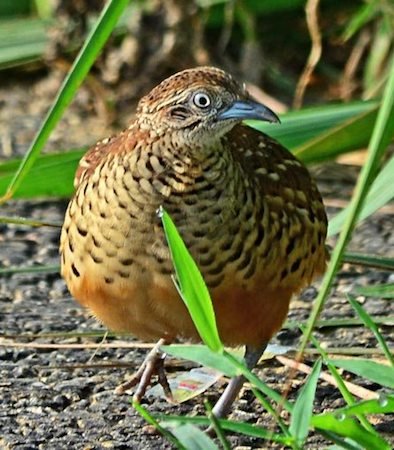Turnicidae – Buttonquails

The Turnicidae otherwise known as Buttonquail or hemipodes are members of a small family of birds, which resemble, but are unrelated to, the quails of Phasianidae. They inhabit warm grasslands in Asia, Africa, Europe, and Australia. There are 17 species in two genera, with most species being found in the genus Turnix and only one being found in the genus Ortyxelos.
Buttonquails are small, drab, running birds, which avoid flying. The female is the more richly-coloured of the sexes, and initiates courtship. While the Quail-plover is thought to be monogamous, Turnix buttonquails are sequentially polyandrous; both sexes cooperate in building a nest in the earth, but normally only the male incubates the eggs and tends the young, while the female may go on to mate with other males. The eggs hatch after an incubation period of 12 or 13 days, and the young fly within two weeks.
A group of small terrestrial birds; the smallest species is the Quail-plover, the only species in the genus Ortyxelos, which is 10cm in length and weighs only 20g. The buttonquails in the genus Turnix range from 12cm to 23cm in length and weigh between 30g and 130g. They superficially resemble the true quails of the genus Coturnix, but differ from them in lacking a hind toe and a crop. The females of this family also possess a unique vocal organ created by an enlarged trachea and inflatable bulb in the oesophagus, which they use to produce a booming call.
According to the IOC there are 17 species in this family, which are:
Common Buttonquail Turnix sylvaticus
Red-backed Buttonquail Turnix maculosus
Hottentot Buttonquail Turnix hottentottus
Black-rumped Buttonquail Turnix nanus
Yellow-legged Buttonquail Turnix tanki
Spotted Buttonquail Turnix ocellatus
Barred Buttonquail Turnix suscitator
Madagascan Buttonquail Turnix nigricollis
Black-breasted Buttonquail Turnix melanogaster
Chestnut-backed Buttonquail Turnix castanotus
Buff-breasted Buttonquail Turnix olivii
Painted Buttonquail Turnix varius
Worcester’s Buttonquail Turnix worcesteri
Sumba Buttonquail Turnix everetti
Red-chested Buttonquail Turnix pyrrhothorax
Little Buttonquail Turnix velox
Quail-plover Ortyxelos meiffrenii
-
Barred Buttonquail Turnix suscitator
Species AccountSound archive and distribution map. -
Barred Buttonquail Turnix suscitator
Species AccountThe barred buttonquail or common bustard-quail (Turnix suscitator) is a buttonquail, one of a small family of birds which resemble, but are unrelated to, the true quails. This species is resident from India across tropical Asia to south China, Indonesia and the Philippines. -
Common Buttonquail Turnix sylvaticus
IUCN Species Status -
Common Buttonquail Turnix sylvaticus
Species AccountSound archive and distribution map. -
Common Buttonquail Turnix sylvaticus
Species AccountThe common buttonquail, Kurrichane buttonquail, small buttonquail, or Andalusian hemipode (Turnix sylvaticus) is a buttonquail, one of a small family of birds which resemble, but are unrelated to, the true quails. This species is resident from southern Spain and Africa through India and tropical Asia to Indonesia.
-
Number of bird species: 17
-
Pheasants, Partridges & Grouse
A Guide to the Pheasants, Partridges, Quails, Grouse, Guineafowl, Buttonquails and Sandgrouse of the World by Steve Madge & Phil McGowan Helm 2002 ISBN: 0713639660 Buy this book from NHBS.com
-
Button Quail Home Page
WebsiteWelcome to the Button Quail Home Page! This site is dedicated to the cutest little birds known to Humankind (I`ll bet you always wanted to know where the phrase Cute as a Button came from, didn`t you? Well, now you know!). This site is intended not only to pay homage to these feathery little sweeties, but also to present some useful information for Quail devotees that will make your Button`s life happier, healthier and safer…
